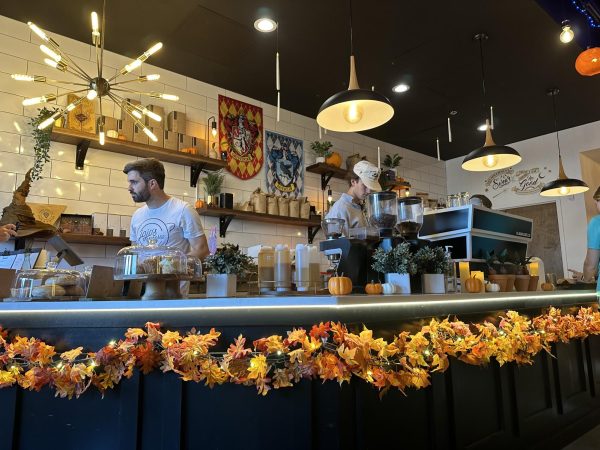Breaking the Mold
A senior’s passion for pottery becomes a business
Photo: Jack Seigerman
Brandon begins the process by wedging his clay, preparing it for optimal use. George started his own business this year, Grey’s Ceramics where he has been extremely successful in selling his work.
Senior George Brandon pulls one bowl from a stack of many.
He’s glazing today, one of the final steps in the extended process of creating pottery. This one is littered with holes across the lower half. He tells me it’s a berry bowl, meant for both rinsing and displaying fruit.
Slowly and carefully, he lowers the clay creation into a five-gallon glaze bucket with his hands. Soon, it’s submerged in swirling shades of mulberry.
It drips as he pulls it out of the bucket. Brandon adjusts his grip, exposing the few naked spots of clay that were formerly covered by his hands. He dips again, and when the bowl emerges it’s fully coated.
He sets his bowl aside and picks up another, and the process picks up another, and the process continues.
Brandon took his first pottery class the first semester of his junior year. He was hooked instantly.
“I liked it immediately,” he said.
But that surface-level interest soon became much more. A class he signed up for at the end of his sophomore year turned into an activity he not only looked forward to, but one that consumed day after day until all his free time was spent in the art room, honing his craft into something beyond a simple schedule requirement.
At the end of his junior year, he signed up for pottery again. Creating pottery in the upper school art room took over his study halls, then became the subject of halls, then became the subject of his college essay, and is now his Specialized Independent Study [SIS].
The “culminating academic and intellectual experience for and intellectual experience for students” at St.George’s according to the school’s website, the SIS is a project upperclassmen design and project upperclassmen design and complete before graduation.
Students typically work on something they are already familiar with or interested in. Past and current examples include building a skateboard from scratch, creating a field map of a planet, or organizing book drives for local schools.
Around the second semester of his junior year, George started to mull over the idea of starting a pottery business for his SIS.
He planned to sell his pottery — a variety of bowls, plates and more — primarily on Instagram, though with a brief stint at the St. George’s Art Show, spanning from Nov. 11 to Nov. 12.
His business, Grey’s Ceramics, was an instant hit. He had completely sold out of his extensive stock by midday on the first day.
Ms. Allison Webb, one of St. Georges’s artists in residence said being able to provide a student with the means to explore their passions is very gratifying for her.
“As teachers, it just fills our soul to know that we’re teaching students things that truly impact their lives and the world later on,” she said.
Brandon doesn’t see his passion ending when the school year does.
“Right now I’m thinking of probably keeping the business open,” he said.
And in the meantime his experience is proving useful for his college application essays. “I wrote partly about pottery,” he said, “and partly about how you can learn from your about how you can learn from your mistakes.”
Brandon, a self-described perfectionist, has had to learn how to deal has had to learn how to deal with the mess-ups that are inevitable when learning a new skill.
“When I first started, I wasn’t very good,” he said, “but after each class, I got better and better”.
Over a year into his practice of the art form, he still isn’t immune to messing up on occasion, even if it’s difficult to tell when looking at his finished pieces.
“If I make a mistake, I can make something else,” he said. To demonstrate he showed a planter that was intended to be a bowl before he accidentally cut too deep into the bottom.
Brandon credits Florian Gadsby, a London-based potter who posts YouTube videos of himself at work, for helping him accept his errors.
“He sometimes even puts in a compilation of his mistakes,”he said.
Now instead of completely scraping his mistakes and starting over, Brandon tries to make something out of them.
“One of the reasons I like pottery is because if you make a mistake, you can reclaim it,” he said. “You can reclaim whatever you make, and then try again.”
Brandon said that some of his least favorite pieces are the ones others like the most. His pottery has reinforced a lesson able to be applied far beyond his potter’s wheel.
“You can make a mistake,” he said, “but you can always try again.”









